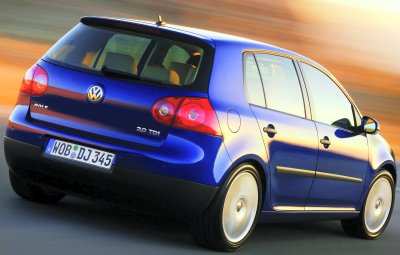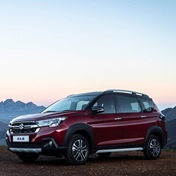
Looking for a quality used vehicle? CLICK HERE!
Yes, Volkswagen has done it again, producing a car which is bigger, better, and once more the superb driver's car that has always been the keynote of the Golf brand.
Yesterday I drove both 1.6-litre and 2-litre petrol versions of the car on a taxing route that incorporated two of my favourite mountain passes.
Both cars passed these ride and handling tests with ease, while some rougher roads proved that the massive advances Volkswagen engineers say they have made to the rear suspension and body really work in improving ride quality without compromising roadholding.
There are six models in the current lineup, which will start to roll out of dealerships from August, with the much sought-after 147 kW Golf GTI coming into the market in March next year.
Three specification levels are offered, and four engines - two petrol and two diesel.
The lineup comprises:
Golf 1.6 Trendline R166 500
Golf 1.6 Comfortline R184 270
Golf 1.6 Comfortline tiptronic R195 990
Golf 1.9 TDI Comfortline R198 180
Golf 2.0 FSI Sportline R209 200
Golf 2.0 TDI Sportline R227 820.
These prices represent an overall increase across the range of 3.8%.
Volkswagen says the increases are consistent with generally higher levels of specification and technology, as well as the fact that manufacturing costs have increased. The new Golfs also have the longest warranty period in SA, at 3 years/120 00 km, with a 12 years anti-corrosion guarantee and a 5 years/60 000 km AutoMotion maintenance plan.
However, some models, such as the 1.9 TDI, are in fact lower-priced than the cars they replace.
When I quizzed marketing director Jolyon Nash about pricing, he said company had contained price increases for more than a year, but had been faced with rising labour and infrastructural costs which meant the new Golf would have to be launched at a higher price than the outgoing model.
Engines
The 1.6-litre engines are different to those available in the outgoing Golf models, although power output is virtually unchanged, with 75 kW at 5 600 r/min and 148 Nm of torque at 3 800 r/min. Top speed on the 1.6 models is 184 km/h and 0-100 km/h is dispatched in just 11.4 seconds. Overall fuel consumption is 7.2 litres/100 km.
The 2-litre FSI 16-valve DOHC motor features direct injection and stratified charge to give more power with better economy. Its 110 kW comes at 6 000 r/min with 200 Nm of torque at 3 500 r/min. Top speed is 206 km/h and it does 0-100 km/h in 8.9 seconds while recording overall fuel consumption of 7.2 litres/100 km.
The two turbo-diesel engines are distinctly different, although both feature Volkswagen pump injection technology.
The 1.9-litre TDI unit is the same as that on the outgoing TDI, producing 77 kW at 4 000 r/min and 250 Nm of torque at 1 900 r/min. Top speed on the 1.6 models is 187 km/h and 0-100 km/h is dispatched in just 11.3 seconds. Overall fuel consumption is 5 litres/100 km.
The top-of-the-range 2.0 TDI has a new 16-valve engine - the same as that on the recently launched Touran MPV - with 103 kW at 4 000 r/min and 320 Nm at a lowly 1 750 r/min. Its top speed is 203 km/h and 0-100 km/h comes up in 9.3 seconds.
The two 2-litre models get a long-legged 6-speed gearbox as standard, with sixth a fuel-saving overdrive gear, while the other models have 5-speed 'boxes.
The cars are generally well-equipped and all models get ABS brakes with electronic brake force distribution (EBD) as well as ASC anti-skid control.
Other safety features include no fewer than six airbags, and the new Golf has gained the coveted Euro NCAP 5-star award for its crashworthiness.
In fact, the Golf was one of the first cars to be tested for child safety protection, and the additional points this gained the car (which others have not been tested for) has made it the highest scorer in the tests to date.
All of which makes it one mean machine, as I can attest after driving the car HARD and fast.
On the road
Volkswagen's aim with the new Golf was to ensure that driving pleasure is paramount, and this shows at the first turn of the wheel. The car has extremely crisp handling, with very positive turn-in, and the new electrical power assistance gives excellent road feel when driving hard while allowing easy parking in town.
The new Golf chassis is extremely stiff - 80% better than before - and this shows on the road. We pushed the car hard through the Cape's famous Bain's Kloof and Viljoen's passes, and found the car extremely forgiving and very, very neutral. Add in ASC, and you'd have to be either daft or inept to get into trouble.
We only drove the petrol units yesterday (I'll tell you about the diesels tomorrow) and both we superb.
The 1600 is a "cooking" engine, with enough power at sea level without pulling out any tress, but the 2-litres is a real eye opener.
Not only is it a free revving unit, but it pulls from really low down, giving superb driveability while offering a great turn of speed.
And the computer showed that economy is a really strong point, with even our extremely hard driving not enough to show an average of just over 9 litres/100 km, mountain passes and top speed tests included.
Features
The new Golf is the biggest yet, and dimensions have increased by 24mm for width, 41mm for height and 55mm for length.
The rear passengers reap the most benefits, with legroom increased by 52mm, while headroom has gone up by 24mm at the rear and 8mm at the front.
Designer Marc Lichte was at the launch in Stellenbosch, and it is obvious this young and vibrant 34 year old has had a lot to do with the vibrancy that comes across in Golf 5.
None of the essence of the Golf range has been lost, but Lichte has managed stamp his own mark on the car, displaying some key characteristics that are definitely vintage Golf, while some features are almost futuristic and not seen before on any Volkswagen product.
The four round headlights, bigger on the sides and smaller in the middle are just one example of a tradition being continued, while the heavy C-pillar also continues a long-standing Golf tradition.
The bonnet and the lower sills of the car however are unlike anything seen in Golf before.
The fenders are raised more prominently than the previous generation, while the bonnet is flat and aggressive.
Another interesting but equally challenging task was successfully sketching and producing more wedged lower side panels while retaining the Golf's overall round looks. The end result is a car that looks smaller, but is actually bigger; that looks like Golf but is unmistakably new.
Form-fitting seats
Inside the seats have been re-designed to provide maximum comfort and lumbar support, while the head-rests work in tandem with the rest of the car's safety mechanisms in the case of a rear-end crash.
In all but the 1.6 Trendline the rear seats have foldaway centre armrests, opening to the luggage compartment, while the Trendline's rear seat can be fully folded to extend the luggage capacity in a 60/40 configuration.
The windows are tinted all round, all models have electric windows front and rear except the 1.6 Trendline (which has front electric windows only), while an electric sun roof is optional across the range.
The outside rear view mirrors are electrically operated and separately heated for cold weather, and are all colour-coded even on the base model. The anti-dazzle internal rear-view mirror is standard, manually operated on the base model but otherwise automatic on all other new Golfs.
Driving pleasure is enhanced by a wide range of electronic features and aids which include the on-board multi-function computer display in the instrument cluster.
This computer displays information ranging from fuel consumption current and average, fuel tank range to average speed and driving time. The radio control buttons and switches are large and easy to grip while not intruding on the overall aesthetic appeal of the interior. The plastics are solid and blend in well with the rest of the instruments in the cabin area.
The steering column is rake and reach adjustable with Servotronic speed-sensitive steering. In layman's terms, this new steering system reduces the amount of power assistance to the steering effort the faster the car goes
ET come home
The headlights are height adjustable, and have a "coming home" function which switches them on as soon as the car's doors are unlocked so that the driver can see while approaching the car in the dark.
Conversely, the lights help when the driver is leaving the car at night, remaining on for a period that allows the driver to get into the house or a well-lit area. This function is standard on all Golfs except the 1.6 Trendline.
Air conditioning is standard across the range, and includes a feature which makes it shut down to recirculate mode when reverse is selected - to stop exhaust fumes entering the car - and there's a dual mode on top models which allows driver and passenger to select their own temperatures. The system also senses if the sun is shining more on one side of the car than the other, and compensates accordingly.
Even Comfortline models get rain sensing wipers and a 12 volt power point in the back, as well as a front-loader radio/CD with no fewer than 10 speakers, plus cruise control.
Trendline models have 15 inch steel wheels with full width covers while Comfortline get 15 inch alloy wheels and Sportline models add colour coding all round plus 16 inch alloys.
Inside Sportline models also feature Titanium-look inserts on the dash as well as sports seats and leather covering for the steering wheel, gear knob and handbrake gaiter.
There's also a built-in bottle opener in the cupholders and towbar preparation.
Options include satellite navigation for R19 000, leather upholstery at R9 000 on Comfortline versions or R8 000 on the Sportline models, and a wood trim package can be had for R3 000.
Spend the bucks - it uplifts the interior!
Summary
Although the price increases are disappointing, we see the logic (sort of).
That apart, Golf makes a quantum leap forward in its latest incarnation. Volkswagen wants to sell 5 000 units the rest of this year, settling down to 8 000 cars a year after that, and we can't see anything standing in its way.
Certainly, with an export programme that will pump out 40 000 cars to Australia and Japan in the next few years, we see Golf 5 as another tower on the Volkswagen skyline.
Under the skin is a new suspension with McPherson struts in the front, and a dynamic multi-link rear axle.
Service is needed every 15 000km, with an oil change needed every 7 500km for the TDI engines. The oil change will remain until the quality of diesel improves.
Looking for a quality used vehicle? CLICK HERE!




 Publications
Publications
 Partners
Partners















